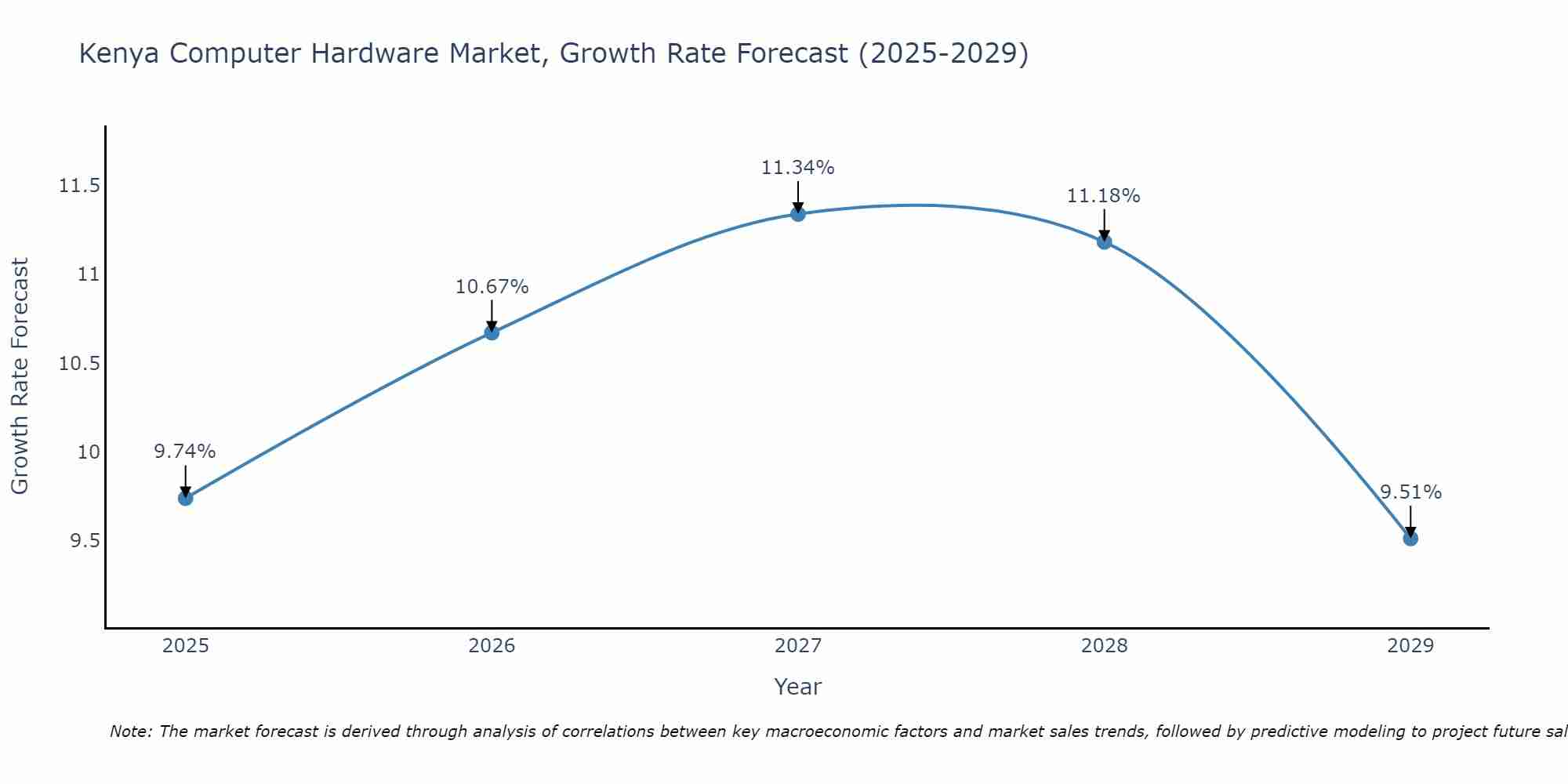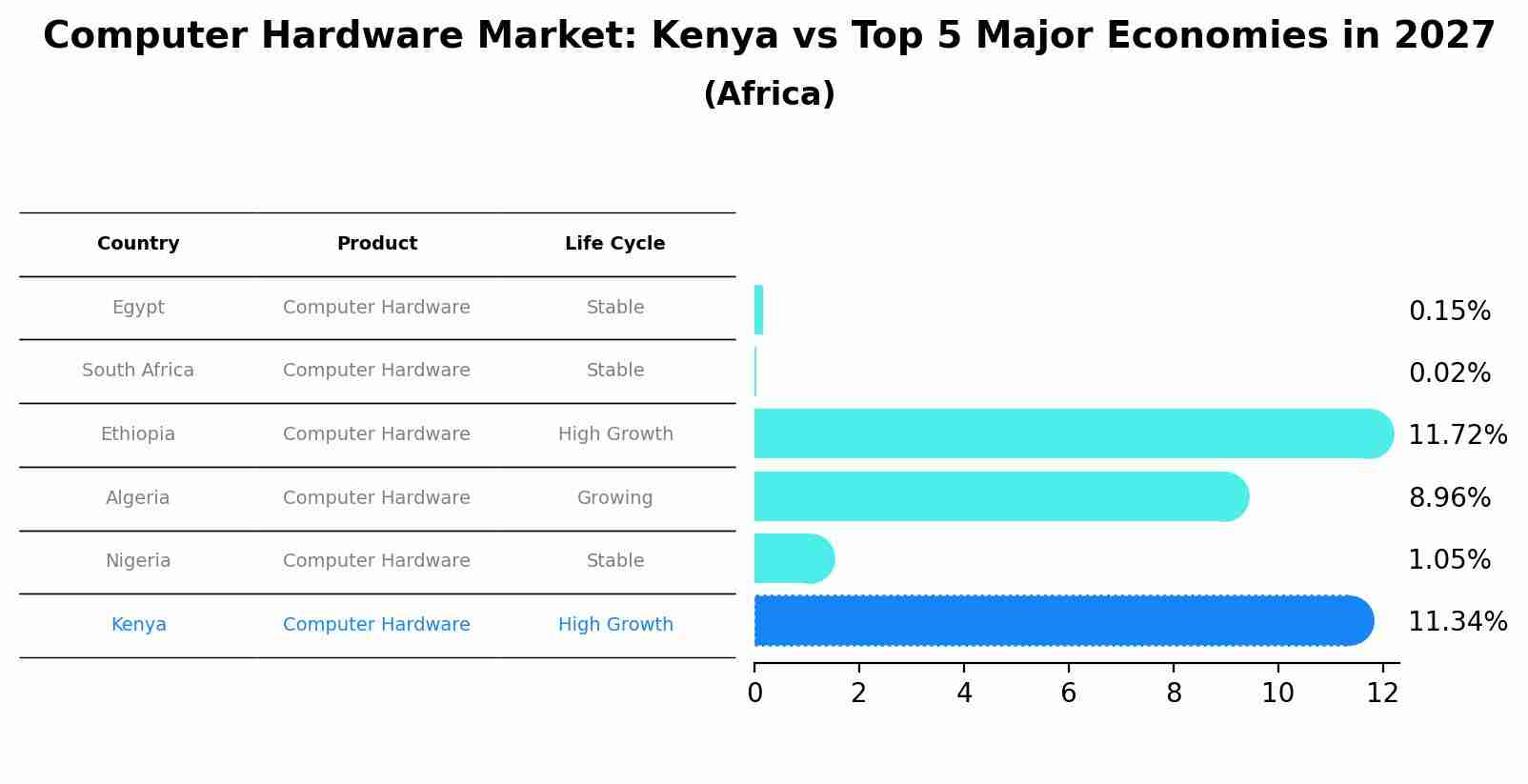Kenya Computer Hardware Market Outlook | Companies, Size, Share, COVID-19 IMPACT, Analysis, Forecast, Industry, Trends, Revenue, Growth & Value
| Product Code: ETC259910 | Publication Date: Aug 2022 | Updated Date: Aug 2025 | Product Type: Market Research Report | |
| Publisher: 6Wresearch | No. of Pages: 75 | No. of Figures: 35 | No. of Tables: 20 | |
Kenya Computer Hardware Market Size Growth Rate
The Kenya Computer Hardware Market is projected to witness mixed growth rate patterns during 2025 to 2029. Starting at 9.74% in 2025, the market peaks at 11.34% in 2027, and settles at 9.51% by 2029.

Computer Hardware Market: Kenya vs Top 5 Major Economies in 2027 (Africa)
The Computer Hardware market in Kenya is projected to grow at a high growth rate of 11.34% by 2027, highlighting the country's increasing focus on advanced technologies within the Africa region, where Egypt holds the dominant position, followed closely by South Africa, Ethiopia, Algeria and Nigeria, shaping overall regional demand.

Kenya Computer Hardware Market Overview
The Kenya Computer Hardware Market involves the sale and distribution of physical components and peripherals used in computing devices such as desktops, laptops, servers, and networking equipment. Computer hardware includes processors, memory modules, storage devices, motherboards, and input/output devices. In Kenya growing digital economy, where businesses, educational institutions, and individuals increasingly rely on technology for productivity and connectivity, the computer hardware market addresses the demand for reliable, efficient, and affordable computing solutions.
Drivers of the market
The Kenya computer hardware market is driven by factors such as increasing digitization, rising demand for personal computers (PCs) and laptops, and growing adoption of IT infrastructure by businesses and educational institutions. Computer hardware components, including processors, memory modules, and storage devices, form the foundation of modern computing systems. With the ongoing digital transformation across sectors and the need for efficient computing solutions, the demand for computer hardware is expected to remain robust, driving market growth.
Challenges of the market
Challenges in Kenya computer hardware market include fluctuating currency exchange rates affecting import costs, limited access to the latest technology due to importation delays, and infrastructure constraints impacting distribution networks. Additionally, affordability barriers for consumers hinder market expansion.
Government Policy of the market
The Kenya government may implement policies to support the computer hardware market, including regulations for product quality, safety standards, and import/export procedures for hardware manufacturers and distributors. Additionally, there may be initiatives to promote technology adoption, investment in local assembly and manufacturing, and skills development in hardware engineering and maintenance to enhance digital infrastructure, expand access to information and communication technologies (ICTs), and stimulate economic development in Kenya.
Key Highlights of the Report:
- Kenya Computer Hardware Market Outlook
- Market Size of Kenya Computer Hardware Market, 2021
- Forecast of Kenya Computer Hardware Market, 2028
- Historical Data and Forecast of Kenya Computer Hardware Revenues & Volume for the Period 2018 - 2028
- Kenya Computer Hardware Market Trend Evolution
- Kenya Computer Hardware Market Drivers and Challenges
- Kenya Computer Hardware Price Trends
- Kenya Computer Hardware Porter's Five Forces
- Kenya Computer Hardware Industry Life Cycle
- Historical Data and Forecast of Kenya Computer Hardware Market Revenues & Volume By Type for the Period 2018 - 2028
- Historical Data and Forecast of Kenya Computer Hardware Market Revenues & Volume By Computer Peripheral Equipment for the Period 2018 - 2028
- Historical Data and Forecast of Kenya Computer Hardware Market Revenues & Volume By Computer Storage Devices and Servers for the Period 2018 - 2028
- Historical Data and Forecast of Kenya Computer Hardware Market Revenues & Volume By Computers for the Period 2018 - 2028
- Historical Data and Forecast of Kenya Computer Hardware Market Revenues & Volume By End-User for the Period 2018 - 2028
- Historical Data and Forecast of Kenya Computer Hardware Market Revenues & Volume By Household for the Period 2018 - 2028
- Historical Data and Forecast of Kenya Computer Hardware Market Revenues & Volume By Commercial for the Period 2018 - 2028
- Historical Data and Forecast of Kenya Computer Hardware Market Revenues & Volume By Distribution Channel for the Period 2018 - 2028
- Historical Data and Forecast of Kenya Computer Hardware Market Revenues & Volume By Online for the Period 2018 - 2028
- Historical Data and Forecast of Kenya Computer Hardware Market Revenues & Volume By Offline for the Period 2018 - 2028
- Kenya Computer Hardware Import Export Trade Statistics
- Market Opportunity Assessment By Type
- Market Opportunity Assessment By End-User
- Market Opportunity Assessment By Distribution Channel
- Kenya Computer Hardware Top Companies Market Share
- Kenya Computer Hardware Competitive Benchmarking By Technical and Operational Parameters
- Kenya Computer Hardware Company Profiles
- Kenya Computer Hardware Key Strategic Recommendations
Frequently Asked Questions About the Market Study (FAQs):
1 Executive Summary |
2 Introduction |
2.1 Key Highlights of the Report |
2.2 Report Description |
2.3 Market Scope & Segmentation |
2.4 Research Methodology |
2.5 Assumptions |
3 Kenya Computer Hardware Market Overview |
3.1 Kenya Country Macro Economic Indicators |
3.2 Kenya Computer Hardware Market Revenues & Volume, 2021 & 2028F |
3.3 Kenya Computer Hardware Market - Industry Life Cycle |
3.4 Kenya Computer Hardware Market - Porter's Five Forces |
3.5 Kenya Computer Hardware Market Revenues & Volume Share, By Type, 2021 & 2028F |
3.6 Kenya Computer Hardware Market Revenues & Volume Share, By End-User, 2021 & 2028F |
3.7 Kenya Computer Hardware Market Revenues & Volume Share, By Distribution Channel, 2021 & 2028F |
4 Kenya Computer Hardware Market Dynamics |
4.1 Impact Analysis |
4.2 Market Drivers |
4.2.1 Increasing adoption of digital technologies and internet connectivity in Kenya |
4.2.2 Growth in demand for personal computers and laptops for remote work and online learning |
4.2.3 Rising investments in IT infrastructure and hardware by businesses and government entities |
4.3 Market Restraints |
4.3.1 High import duties and taxes on computer hardware impacting affordability |
4.3.2 Limited availability of skilled IT professionals for maintenance and support services |
5 Kenya Computer Hardware Market Trends |
6 Kenya Computer Hardware Market, By Types |
6.1 Kenya Computer Hardware Market, By Type |
6.1.1 Overview and Analysis |
6.1.2 Kenya Computer Hardware Market Revenues & Volume, By Type, 2018 - 2028F |
6.1.3 Kenya Computer Hardware Market Revenues & Volume, By Computer Peripheral Equipment, 2018 - 2028F |
6.1.4 Kenya Computer Hardware Market Revenues & Volume, By Computer Storage Devices and Servers, 2018 - 2028F |
6.1.5 Kenya Computer Hardware Market Revenues & Volume, By Computers, 2018 - 2028F |
6.2 Kenya Computer Hardware Market, By End-User |
6.2.1 Overview and Analysis |
6.2.2 Kenya Computer Hardware Market Revenues & Volume, By Household, 2018 - 2028F |
6.2.3 Kenya Computer Hardware Market Revenues & Volume, By Commercial, 2018 - 2028F |
6.3 Kenya Computer Hardware Market, By Distribution Channel |
6.3.1 Overview and Analysis |
6.3.2 Kenya Computer Hardware Market Revenues & Volume, By Online, 2018 - 2028F |
6.3.3 Kenya Computer Hardware Market Revenues & Volume, By Offline, 2018 - 2028F |
7 Kenya Computer Hardware Market Import-Export Trade Statistics |
7.1 Kenya Computer Hardware Market Export to Major Countries |
7.2 Kenya Computer Hardware Market Imports from Major Countries |
8 Kenya Computer Hardware Market Key Performance Indicators |
8.1 Average time spent online per user in Kenya |
8.2 Number of new IT companies entering the Kenyan market |
8.3 Percentage of government budget allocated to IT infrastructure development |
9 Kenya Computer Hardware Market - Opportunity Assessment |
9.1 Kenya Computer Hardware Market Opportunity Assessment, By Type, 2021 & 2028F |
9.2 Kenya Computer Hardware Market Opportunity Assessment, By End-User, 2021 & 2028F |
9.3 Kenya Computer Hardware Market Opportunity Assessment, By Distribution Channel, 2021 & 2028F |
10 Kenya Computer Hardware Market - Competitive Landscape |
10.1 Kenya Computer Hardware Market Revenue Share, By Companies, 2021 |
10.2 Kenya Computer Hardware Market Competitive Benchmarking, By Operating and Technical Parameters |
11 Company Profiles |
12 Recommendations |
13 Disclaimer |
- Single User License$ 1,995
- Department License$ 2,400
- Site License$ 3,120
- Global License$ 3,795
Search
Related Reports
- UAE Building Thermal Insulation Market Outlook (2025-2031) | Revenue, Companies, Share, Trends, Growth, Size, Forecast, Industry, Analysis & Value
- Portugal Electronic Document Management Market (2025-2031) | Strategy, Consumer Insights, Analysis, Investment Trends, Opportunities, Growth, Size, Share, Industry, Revenue, Segments, Value, Segmentation, Supply, Forecast, Restraints, Outlook, Competition, Drivers, Trends, Demand, Pricing Analysis, Competitive, Strategic Insights, Companies, Challenges
- France Electronic Document Management Market (2025-2031) | Strategy, Consumer Insights, Analysis, Investment Trends, Opportunities, Growth, Size, Share, Industry, Revenue, Segments, Value, Segmentation, Supply, Forecast, Restraints, Outlook, Competition, Drivers, Trends, Demand, Pricing Analysis, Competitive, Strategic Insights, Companies, Challenges
- Portugal Occupational Health & Safety Services Market (2025-2031) | Strategy, Consumer Insights, Analysis, Investment Trends, Opportunities, Growth, Size, Share, Industry, Revenue, Segments, Value, Segmentation, Supply, Forecast, Restraints, Outlook, Competition, Drivers, Trends, Demand, Pricing Analysis, Competitive, Strategic Insights, Companies, Challenges
- Netherlands Occupational Health and Safety Services Market (2025-2031) | Strategy, Consumer Insights, Analysis, Investment Trends, Opportunities, Growth, Size, Share, Industry, Revenue, Segments, Value, Segmentation, Supply, Forecast, Restraints, Outlook, Competition, Drivers, Trends, Demand, Pricing Analysis, Competitive, Strategic Insights, Companies, Challenges
- Belgium and Luxembourg Facility Management Market (2025-2031) | Strategy, Consumer Insights, Analysis, Investment Trends, Opportunities, Growth, Size, Share, Industry, Revenue, Segments, Value, Segmentation, Supply, Forecast, Restraints, Outlook, Competition, Drivers, Trends, Demand, Pricing Analysis, Competitive, Strategic Insights, Companies, Challenges
- Russia Women Intimate Apparel Market (2025-2031) | Strategy, Consumer Insights, Analysis, Investment Trends, Opportunities, Growth, Size, Share, Industry, Revenue, Segments, Value, Segmentation, Supply, Forecast, Restraints, Outlook, Competition, Drivers, Trends, Demand, Pricing Analysis, Competitive, Strategic Insights, Companies, Challenges
- Africa Chocolate Market (2025-2031) | Size, Share, Trends, Growth, Revenue, Analysis, Forecast, industry & Outlook
- Global Hydroxychloroquine And Chloroquine Market (2025-2031) | Industry, Trends, Size, Outlook, Growth, Value, Companies, Revenue, Analysis, Share, Forecast
- Saudi Arabia Plant Maintenance Market (2025-2031) | Industry, Size, Growth, Revenue, Value, Companies, Forecast, Analysis, Share & Trends
Industry Events and Analyst Meet
Our Clients
Whitepaper
- Middle East & Africa Commercial Security Market Click here to view more.
- Middle East & Africa Fire Safety Systems & Equipment Market Click here to view more.
- GCC Drone Market Click here to view more.
- Middle East Lighting Fixture Market Click here to view more.
- GCC Physical & Perimeter Security Market Click here to view more.
6WResearch In News
- Doha a strategic location for EV manufacturing hub: IPA Qatar
- Demand for luxury TVs surging in the GCC, says Samsung
- Empowering Growth: The Thriving Journey of Bangladesh’s Cable Industry
- Demand for luxury TVs surging in the GCC, says Samsung
- Video call with a traditional healer? Once unthinkable, it’s now common in South Africa
- Intelligent Buildings To Smooth GCC’s Path To Net Zero













